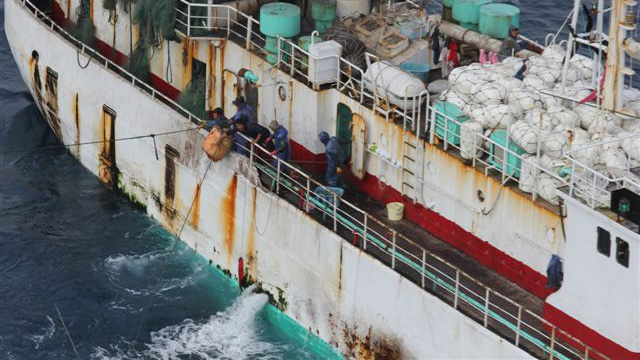Recommendations for the 69th Session of the United Nations General Assembly
Consideration of the 2014 Oceans and the Law of the Sea Resolution comes at the end of a pivotal year. Member States of the United Nations have advanced their deliberations on protections for biodiversity in areas beyond national jurisdiction. Some progress has also been made in establishing large-scale marine reserves and protected areas needed for lasting conservation. Finally, the United Nations’ Open Working Group on Sustainable Development Goals (OWG) has recommended to the General Assembly that the post-2015 sustainable development framework include a goal specifically on oceans and seas. Member States should take this year’s resolution as an opportunity to consolidate achievements, further their commitments to protect marine biodiversity, and avoid retreating while critical work remains to be done.
 © U.S. Coast Guard
© U.S. Coast Guard
Management gaps can allow for illicit activities to go undetected and undeterred on the high seas. Fortunately, authorities identified this vessel they suspected was fishing illegally.
The ocean contains much of Earth’s biodiversity, but only a tiny fraction of it is protected. Overfishing, pollution, and climate change threaten to degrade areas that remain healthy and teeming with life, diminishing their ability to provide vital services to humankind. The ocean stores roughly one-quarter of annual global carbon emissions. It is now 26 per cent more acidic than it was before the Industrial Revolution, with potentially catastrophic effects on the corals and other organisms that are the foundation of marine ecosystems.
In this increasingly unstable environment, 90 per cent of fish stocks are now either fully fished (61.3 per cent) or overfished (28.8 per cent), up 3 per cent from levels only two years ago. In summary, the ocean’s natural buffers are vanishing. Addressing these challenges will require precautionary management tools such as environmental impact assessments (EIAs) and establishment of large marine protected areas (MPAs). In addition, large-scale, fully protected reserves can help rebuild depleted fish populations and protect vulnerable areas. Scientists have found that reserves and fisheries closures improve species richness and biomass—important indicators for ocean health and resiliency.
There is, however, no mechanism through which countries can create globally recognized, fully protected areas on the high seas. The Convention on Biological Diversity (CBD) calls for identification of ecologically and biologically significant areas in need of protection but does not confer the authority to designate or manage MPAs or reserves. There is also no mechanism requiring EIAs for activities planned on the high seas. Provisions of the United Nations Convention on the Law of the Sea (UNCLOS) and the CBD call for identification and prior assessment of potential threats from high seas activities before they take place. These provisions are only an outline and lack the detail needed for effective implementation.
The 69th session provides an opportunity to protect ocean biodiversity. The United Nations General Assembly can play an important role in creating an environment that enables positive change through the Oceans and the Law of the Sea Resolution.
The United Nations General Assembly can play an important role in creating an environment that enables positive change through the Oceans and the Law of the Sea Resolution.
In particular, this year’s resolution should include text that:
- Reaffirms the commitment to take a decision on the development of a new instrument to protect high seas biodiversity before the end of the 69th General Assembly.
- Calls for further progress toward establishment of fully protected marine reserves and sizable MPAs, especially in ecologically or biologically significant areas, with the aim of achieving at least the Aichi Biodiversity Target of protecting at least 10 per cent of the world’s oceans by 2020.
- Supports the General Assembly’s adoption of an Oceans and Fisheries Sustainable Development Goal for the Global Ocean.







